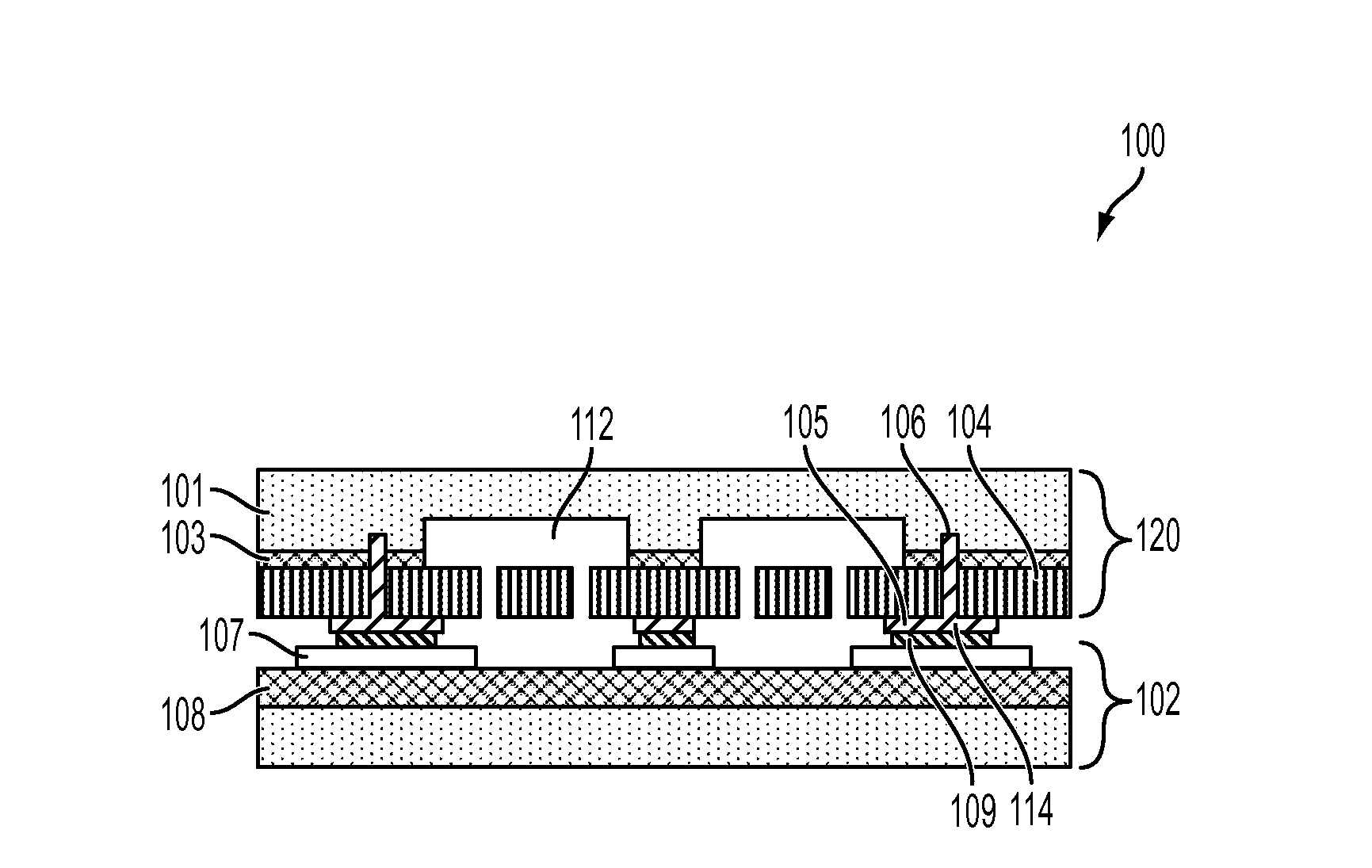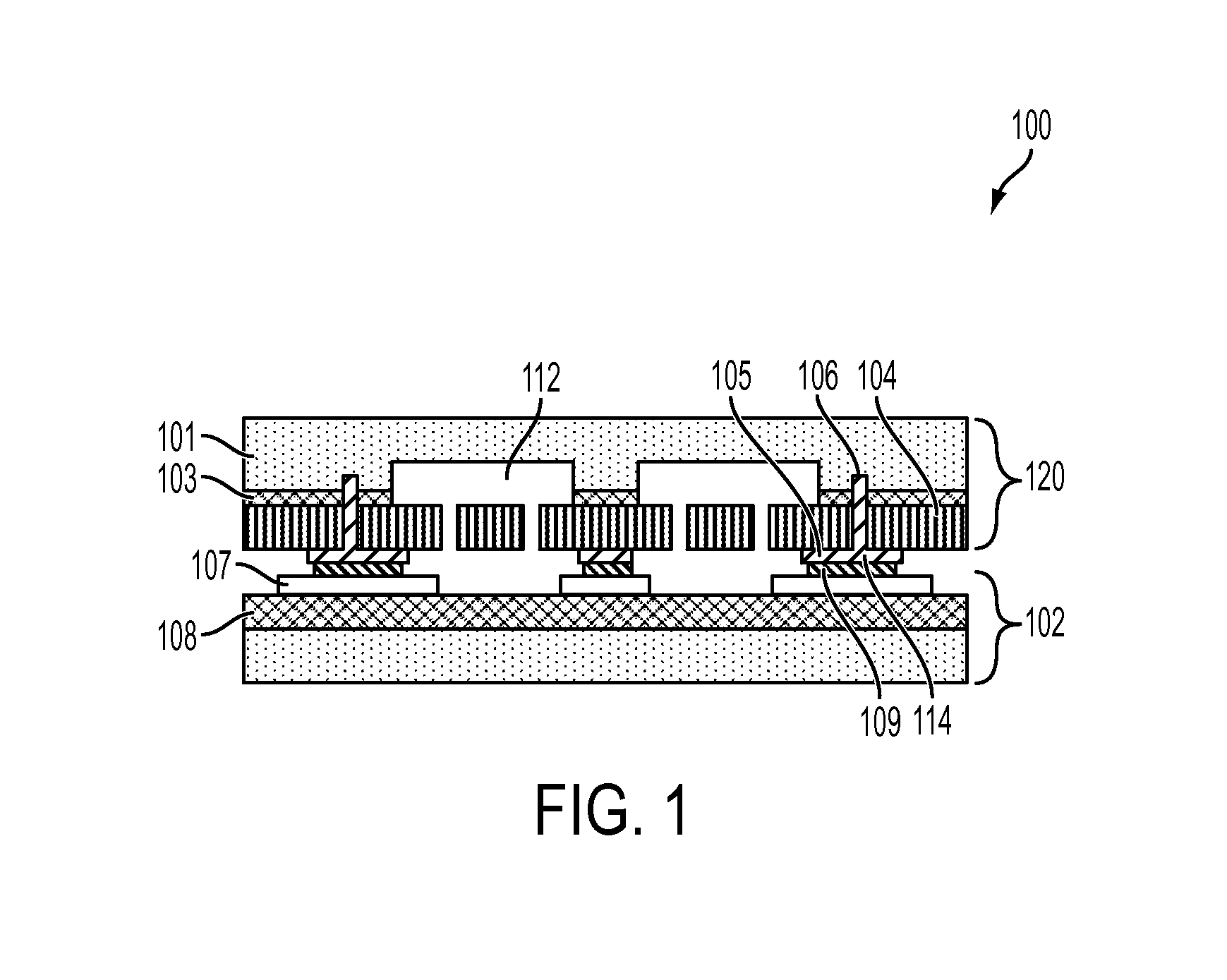Internal electrical contact for enclosed MEMS devices
a technology of electrical contact and mems device, which is applied in the manufacture of microstructural devices, electrical apparatus, and semiconductor devices, etc., can solve the problems of increasing the overall thickness of the mems device when packaged, and the need for vertical space for the wire bond to be completed, so as to reduce the thickness of the device
- Summary
- Abstract
- Description
- Claims
- Application Information
AI Technical Summary
Benefits of technology
Problems solved by technology
Method used
Image
Examples
first embodiment
[0016]FIG. 1 is a diagram which illustrates a cross-section of the bonded MEMS-base substrate device with an internal direct electric coupling in accordance with a An engineered silicon-on-insulator (ESOI) substrate 120 includes a handle layer 101 with cavities 112 and a device layer 104, fusion bonded together with a thin dielectric film 103 (such as silicon oxide) in between the device layer 104 and handle layer 101. An electrical connection between the handle layer 101 and the device layer 104 may be achieved by etching one or more vias 106 through the device layer 104 and the thin dielectric layer 103 into the handle layer 101 and by filling the vias 106 with a conductive material 114, such as polysilicon, tungsten, titanium, titanium nitride, aluminum, or germanium. The MEMS substrate is considered complete after a germanium (Ge) 109 and standoffs 105 comprising conductive material 114 are formed and MEMS actuator structures are patterned and etched in device layer 104. Altern...
second embodiment
[0020]FIG. 3 is a diagram which illustrates a cross-section of the bonded MEMS-base substrate device with an internal direct electric coupling in accordance with a In this embodiment, the electric coupling path is formed from handle layer 201 to MEMS device layer 204, across dielectric film 203, and eventually to base substrate Al pad 207 after MEMS to base substrate AlGe eutectic bonding.
[0021]An ESOI substrate 220 is comprised of a handle layer 201 with cavities 212 and a device layer 204, fusion bonded together with a thin dielectric layer 203 (such as silicon oxide) in between the device layer 204 and handle layer 201. The ESOI substrate is completed after device layer thinning. An electrical connection between handle layer 201 and device layer 204 can be achieved by etching at least one via 206 at any locations through device layer 204 and thin dielectric layer 203 into or exposing the surface of handle layer 201 and filling the via 206 by conductive materials, such as polysil...
third embodiment
[0023]FIG. 4 is a diagram illustrating the electric coupling between handle layer 301. MEMS device layer 304, and base substrate 302 using polysilicon for the device layer 304 and AlGe eutectic bonding. The process flow and fabrication method of MEMS substrate using a surface micro-machining process technique are illustrated in FIGS. 5A-5F. FIGS. 5A-5F are diagrams which illustrate a series of cross-sections illustrating processing steps to build the electric coupling from handle layer 301 to device layer 306 ready to bond to a base substrate 302 for the device of FIG. 4. Starting from FIG. 5A, a thin dielectric layer 303 (typically silicon oxide) is deposited on a handle layer 301. Thereafter the layer 303 is patterned and etched to form vias 312. A silicon layer 306 (FIG. 5B) is deposited onto the handle layer 301 followed by thinning and planarization, (for example grinding or chemical mechanical polishing) to desired device layer thickness. FIG. 50 illustrates an embodiment with...
PUM
 Login to View More
Login to View More Abstract
Description
Claims
Application Information
 Login to View More
Login to View More - R&D
- Intellectual Property
- Life Sciences
- Materials
- Tech Scout
- Unparalleled Data Quality
- Higher Quality Content
- 60% Fewer Hallucinations
Browse by: Latest US Patents, China's latest patents, Technical Efficacy Thesaurus, Application Domain, Technology Topic, Popular Technical Reports.
© 2025 PatSnap. All rights reserved.Legal|Privacy policy|Modern Slavery Act Transparency Statement|Sitemap|About US| Contact US: help@patsnap.com



